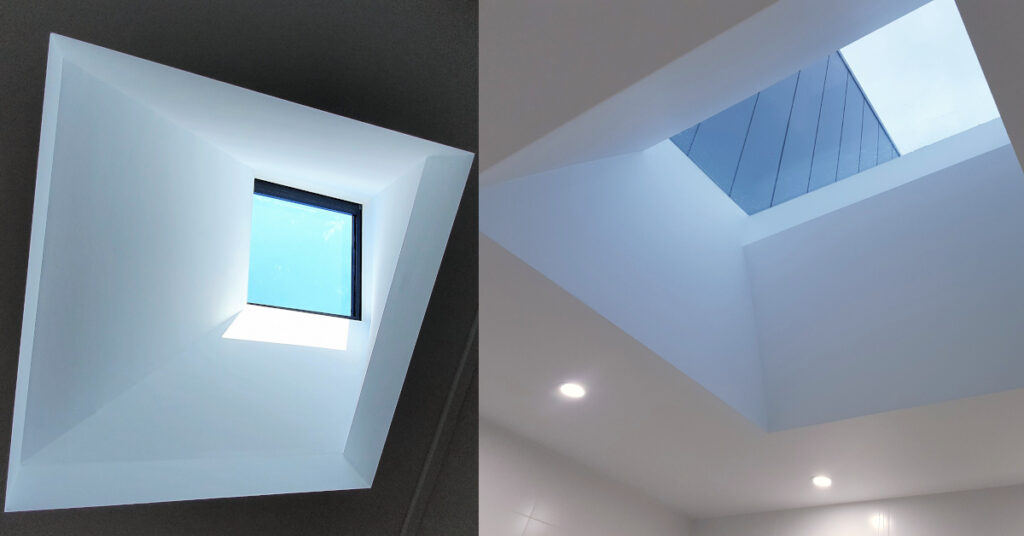
A skylight is a window installed in a roof or ceiling that brings sunlight into a home. They are typically used in rooms where natural light is important such as kitchens, living rooms, and stairwells. Skylights have several benefits including reducing energy costs, improving the quality of indoor air, and providing a source of natural light.
The history of skylights can be traced back to the ancient Romans. The skylight, or oculus, is one of the most iconic features of ancient Roman architecture. The Pantheon is perhaps the most famous example of a skylight in antiquity.
Skylights used to be simple openings in roofs that allowed sunlight to enter homes and other buildings. Over time, skylights became more elaborate, with some featuring stained glass or other decorative elements.
Today, skylights are still a popular feature in both residential and commercial architecture. Skylight buildings are becoming increasingly popular as architects and designers look for innovative ways to create energy-efficient buildings.
Skylight Buildings in History
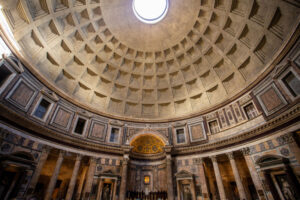
Skylights were first used in Ancient Roman architecture, where they were often positioned above temples and public baths to allow for natural ventilation and lighting. In the Middle Ages, Gothic cathedrals made extensive use of skylights to fill their interiors with light. Today, skylights are still used in a variety of building types for both functional and aesthetic reasons.
Some of the most famous skylight buildings in history include the Pantheon in Rome, Fulton Centre in New York, and the Great Dome in Cambridge, Massachusetts. Each of these buildings features spectacular skylights that contribute to their overall design and beauty.
And now, as cities continue to grow vertically, the demand for more skylight buildings also increases. After all, modern skylight buildings provide many benefits for both occupants and the environment. These buildings are changing the way we live and work in cities.
What Is the Purpose of a Skylight?
The purpose of a skylight is to let natural light into a space. Skylights can help reduce the need for electric lighting, which can save energy and money. They can also improve the appearance of a room and make it feel more spacious.
Not only do they let in natural light, but skylights also help circulate air. Studies have shown that skylights can reduce the amount of dust and other allergens in the air. They also help reduce mould and mildew growth.
Skylight Structure
As more and more people are looking for ways to save on energy costs, skylights have become a popular option for both commercial and residential buildings.
By incorporating a skylight structure into the architectural design of a building, natural light can be used to brighten up interior spaces. Not only does this reduce the need for artificial lighting, but it can also help to create a more pleasant environment and add visual interest to a space.
What Is a Skylight Building?
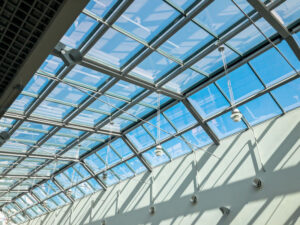
A skylight building is a type of architecture where the roof is designed to allow natural light to enter the interior space. This can be achieved through the use of translucent materials, windows, or other openings in the roof. Skylight buildings are often used in office or commercial settings where it is important to maximise natural light.
There are many benefits to buildings with skylights, such as reducing energy costs, improving air quality, and increasing natural light.
Skylight Panels for Metal Buildings
Skylight panels come in a variety of sizes and shapes and can be made from different materials including glass, polycarbonate, or fibreglass. They can be fixed or operable and can be installed in a variety of ways.
When choosing skylight panels for metal buildings, it is important to consider the climate and the building’s specific needs. There are many different types of skylight panels available, so select the one that will best meet the needs of the building and its occupants.
Architectural Skylights
Though they’ve been used for centuries in a variety of forms, skylights only began to gain popularity in architecture within the past few decades. And while early versions were often little more than a hole in the roof, modern skylights are so much more. Today’s architectural skylights can be used to brighten interiors, create a connection to the outdoors, and even help save on energy costs.
While most windows are designed to simply let in natural light, skylights are designed to be an integral part of the architecture, adding both style and function to a building.
Skylight Ideas for Modern Homes
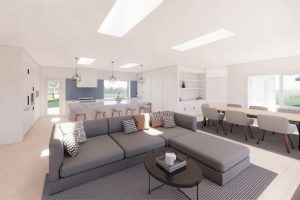
Skylight buildings incorporate the skylight structure into the design and construction of the building. A building with skylights is good for commercial use in particular because it brings in natural light, which can help reduce electric costs. It also can make a space feel more open and inviting, which can be good for business.
Aside from commercial buildings, residential homes can benefit greatly from skylights as well. For starters, you can use skylights to accentuate high ceilings. Tall ceilings can make a living space feel less stuffy and cramped, but adding skylights will open the space up by letting in an abundance of natural light.
If you’re looking for some skylight ideas for your modern home, you’ll want to check out the Vivid Skylights gallery. There are several different styles and designs to choose from, so you’re sure to find something that fits your taste.
Ceiling Skylights in Residential Construction
As the days get shorter and the nights get longer, many of us find ourselves spending more time indoors. And while there are plenty of ways to add some light to your home, there’s nothing quite like natural sunlight.
Ceiling skylights are a great way to bring in some extra light, and they can also help to create a more open and airy feel in your space.
If you are looking for a top-of-the-line ceiling skylight, then look no further than Vivid Skylights. Every skylight product is made with high-quality materials and is designed to withstand even the harshest weather conditions.
Ventilating and Electric Opening Skylights
Ventilating skylights, also called electric opening or operable skylights, are a type of energy-efficient roof window. They are designed to open and close automatically, allowing natural ventilation while still providing excellent insulation against heat loss.
Laminated Glass Skylights for Modern Architecture
Glass skylights are definitely a step up from your average window. Not only do they let in more light, but they also add a touch of luxury to any space.
Laminated glass is the best choice for glass skylights. It is made up of two or more sheets of glass bonded together with a layer of plastic in between. In addition to being a staple of modern architecture, it has been a common practice to use laminated glass in areas where safety is a concern, such as in skylights and storefronts.
Vivid Skylights’ laminated products are a great choice since they are much more durable than traditional skylights and better at insulating your home. Additionally, laminated skylights provide better protection from the sun’s harmful UV rays. If you are looking for a new skylight, be sure to consider a laminated model.
What Are Fixed Skylights?
Fixed skylights are designed to be non-operable, meaning they cannot be opened or closed. This type of skylight is often used in hallways, staircases, attics, and other small spaces where ventilation is not a concern.
Vivid Skylights is a trusted name when it comes to premium fixed skylights. Our skylight products are made with laminated glass and come with durable aluminium frames. Plus, they are covered with a 5-year warranty, so you can rest easy knowing that your investment is protected.
Our fixed skylights are available in a variety of sizes and styles to suit any home, and they’re easy to install – so you can start enjoying the natural light in no time. Make sure to check out our store to choose from a wide selection of leak-proof and non-operable skylights.
Types of Skylights in Architecture
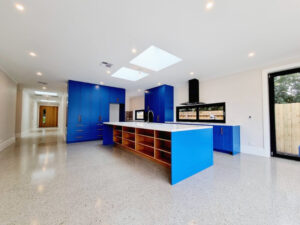
Skylights are an important element in modern architecture. They provide natural light and ventilation and can improve the energy efficiency of a building.
While they are all usually installed on the roof of a building, the types of skylights in architecture might vary. They are available in a range of shapes and sizes as well. They can be round, square, or rectangular, and they can be made from a variety of materials, including glass, plastic, metal, or fibreglass.
Modern skylight architecture such as operable skylights are particularly popular in green and passive solar buildings, as they help to improve the building’s energy efficiency. By allowing natural light and ventilation into the building, operable skylights can reduce the need for artificial lighting and cooling.
Aside from commercial applications, residential skylight design continues to evolve as well. One of the latest trends is the use of smart technology. Many manufacturers are now incorporating smart features into their skylights, such as automatic opening and closing based on weather conditions.
Today’s skylights are more energy-efficient and higher-performing than ever before.
What Are the Different Types of Skylights?
There are different types of skylights available on the market today, and the best option for you depends on your construction needs and budget. While all skylights let in natural light, various types offer different features.
- Dome skylights: This type of skylight consists of a dome-shaped structure placed on the roof. Dome skylights are often used in commercial and industrial buildings, as they are an effective way to let natural light into a large space.
- Fixed skylights: They are the most common type and they don’t open or close. Fixed skylights are often used in rooms with high ceilings.
- Operable skylights: Operable skylights can improve the indoor air quality of your home. Depending on your needs, they can be operated either manually or automatically.
- Electric opening skylights: Type of skylight that opens and closes using an electric motor. Electric opening skylights can be opened and closed using a remote control, switch, or timer.
- Plastic skylights: They are easy to install and are less expensive than glass skylights. Plastic skylights are available in a variety of sizes and styles to fit your needs.
- Electric skylights: Electric skylights or faux skylights are placed on the ceiling and wired to provide artificial light. While they can be useful for first floor or interior rooms that don’t have access to the roof for a traditional skylight to be installed, they do not bathe living spaces with the natural light or ambience that real skylights emanate.
While different types of skylights have been around for centuries, they’re becoming increasingly popular in new construction. And as city dwellers continue to seek out ways to connect with nature, we can expect to see even more skylight buildings in the years to come.
What Are the Pros and Cons of Skylight?
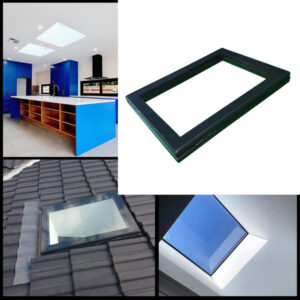
Skylights can be a great addition to any home, providing extra light and a connection to the outdoors. Installing a skylight, however, could potentially have some drawbacks if not installed correctly. Here are some pros and cons of adding a skylight to your home.
Skylights are an increasingly popular feature in today’s homes and for good reason. Skylights have numerous benefits that include reducing energy costs, brightening up dark rooms, and increasing the value of your home.
On the other hand, skylights might leak. If not installed correctly, water can enter through the gaps around the skylight and cause damage to the ceiling and framing below. They are also more susceptible to condensation than regular windows, so there is an increased risk of mould and mildew growth if proper ventilation is not provided.
That’s why it is best to have your skylights professionally installed if you’re not experienced and well versed with tools. You’ll ultimately save time and money by doing this. Most homeowners prefer fixed skylights because they let in more light and can be more energy efficient. They are also less likely to leak than operable skylights, and they require less maintenance.
Different Types of Skylights Used in Buildings
There are many different types of skylights used in buildings. Each type has its set of benefits and possible drawbacks that should be considered when selecting the best option for commercial applications.
Pyramid skylights are one of the most common types used in both homes and businesses. They are typically made from glass or acrylic, and they feature a pyramid-shaped frame that helps to support the weight of the materials.
Dome skylights are another popular option, and they can be made from either glass or polycarbonate. These skylights are typically installed in offices and industrial buildings, as they provide an abundance of natural light.
We also have tubular skylights. They are the most energy-efficient option, as they use reflective tubing to direct sunlight into the interior space. They are also relatively easy to install and can be used in both new construction and retrofit applications.
Melbourne Skylights by Vivid Skylights
If you’re looking for a durable skylight, look no further than Vivid Skylights. We offer premium fixed skylights with a 5-year warranty, and they come in various sizes to fit your needs. Whether you’re looking for a small 650x950mm skylight or a larger 950x1200mm one, Vivid Skylights has you covered. And because all of our products are backed by a 5-year warranty, you can be sure that your investment is protected.
Our Melbourne skylights are made of high-quality materials and are designed to withstand tough Australian weather conditions.
If you’re looking for a one-stop shop for all your skylight needs, check out our skylight store. We have everything you need to make your next construction project a success, including a wide selection of skylights in different sizes.
Not sure what kind of skylight is right for you? Browse our skylight gallery to get inspiration. Contact us today to learn more about our skylight products and services.
